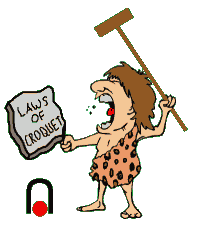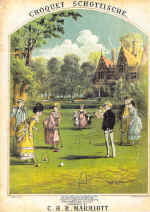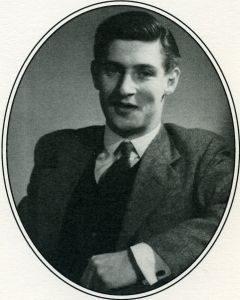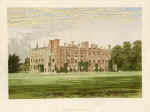 The origins of croquet are shrouded in the mists of time. All we know for certain is that it evolved in Ireland as a social pastime in the
early decades of the nineteenth century and soon spread throughout the
English-speaking world. Propelled by publicity in the British sporting press, it
burst into flower in the early 1860s. No one had seen anything like it – a fun
game that could be played by all, by young and old, by men and women. While the
many, who we know today as players of 'garden croquet', clung to the game as
a social pastime, the few aspired to higher things.
The origins of croquet are shrouded in the mists of time. All we know for certain is that it evolved in Ireland as a social pastime in the
early decades of the nineteenth century and soon spread throughout the
English-speaking world. Propelled by publicity in the British sporting press, it
burst into flower in the early 1860s. No one had seen anything like it – a fun
game that could be played by all, by young and old, by men and women. While the
many, who we know today as players of 'garden croquet', clung to the game as
a social pastime, the few aspired to higher things.
The first code of laws to receive universal recognition in
this country was compiled by the leading clubs in 1870. When the All England
Croquet Club, which had led this initiative, turned its attention to the
development of Lawn Tennis in 1875, croquet went into eclipse. But it was soon
to rise again. In 1897 the clubs around the country regrouped to form the United
All England Croquet Association, soon to be renamed the Croquet
Association,
which remains to this day the game's national governing body and which
continues to play a leading role in the development of croquet worldwide.

(click on image
for an enlargement)
Competition is the essence of croquet. Individual
tournaments, inter-club events, and national championships have been played
since the earliest days. The game went international in 1925 with the
institution of the MacRobertson Shield test series between the leading croquet
nations; and, since the formation in 1989 of the World Croquet Federation, world
championships have been held in most years.
As croquet became increasingly complex, clubs and national
associations looked for ways of simplifying the game to attract new members.
Experiments were held with a variety of novel formats. Today the World Croquet
Federation recognises three forms of the game – Association Croquet, the
traditional game played in most countries, the American Six-Wicket Game, and
Golf Croquet, a hybrid game first recognised by the Croquet Association (now
Croquet England) in 1934.
The game has made huge advances since it was first played in
Victorian times on indifferent lawns with makeshift equipment according to crude
rules. Changes in the laws and tactics, innovations in equipment, and standards
of turf management have advanced hand in hand. Croquet today is just one of a
galaxy of sports and games, keenly contested and highly regulated, like soccer,
cricket, snooker, baseball, lawn tennis, and chess.
See also:
 Dr. David Drazin
Dr. David Drazin
26.12.1931 - 1.5.2014
Croquet historian and
Watford club memberCassiobury
Park, then attached to Cassiobury House in the
ownership of Arthur Algernon Capel, sixth Earl of Essex (by the seventh
creation), was one of the first places in which croquet was played in this
country. The earl caught the croquet bug in the early 1860s and never looked
back. A leading entertainer of high society and energetic entrepreneur, he
hosted lavish croquet parties for the glitterati of the age and marketed the
Cassiobury brand croquet set, manufactured in his own sawmills.

Cassiobury House
(click on image
for an enlargement)
In later years, the Capel family, burdened by increasing
maintenance costs, disposed of the house and surrounding parkland. In a series
of sales, it sold parcels of parkland to Watford Council, to become
Cassiobury Park as we know it today, and in 1922 it sold the main house at
auction. But no one could be found to rescue the grand old house, and in 1927 it
was demolished. The house and croquet grounds occupied an area of land, which is
now part of the Cassiobury residential estate, bounded by Temple Close, The
Gardens, Parkside Drive, and Richmond Drive.
The courts we play on today were laid down by Watford
Council in 1936, just a few hundred yards away, at the other side of
Cassiobury Park.
The present club affiliated to the Croquet
Association, then the national governing body for the game, soon after its formation in 1936. Originally the Cassiobury Croquet Club, the club changed its
name to the Watford (Cassiobury) Croquet Club in 1996 in order to advertise its
location more clearly to visitors from other clubs, to potential new members,
and to the public at large. The club converted itself into a Charitable
Incorporated Organsation - a "CIO" - in 2019, retaining the same name. The
Croquet Association was replaced in 2023 by a CIO named Croquet England.
The club has played on the same two lawns in Cassiobury
Park,
near the Shepherds Road entrance off Cassiobury Park Avenue, since its
formation. A third lawn was added in 2004, and a fourth in 2017. The original clubhouse, a modest
timber structure, was destroyed by fire in 1999 and rebuilt by Watford Council.
A new pavilion was added in 2021, and a new automatic irrigation system with
water supplied from a newly dug borehole was added in 2024 with the help of some
grants, member donations and Gift Aid recoveries from HMRC.
DHD
21.2.05
Updated by SJH in 17.02.25

 Mary Rose
Mary Rose
 Longman Cup
Longman Cup
 Anderson Shield
Anderson Shield
 Beds & Herts League
Beds & Herts League
 AC Regional league play-off
AC Regional league play-off
 AC Friendly inter-club
AC Friendly inter-club
 AC Tour
AC Tour
 GC Inter-Club Championship
GC Inter-Club Championship
 GC Inter-Club (Murphy) Shield
GC Inter-Club (Murphy) Shield
 GC Open League Western Area
GC Open League Western Area
 GC B-Level League Central & West Area
GC B-Level League Central & West Area
 GC B-Level League final
GC B-Level League final
 GC Handicap League Western Area
GC Handicap League Western Area
 GC Handicap League play-off
GC Handicap League play-off
 GC 4-Club Trophy
GC 4-Club Trophy
 GC Friendly inter-club
GC Friendly inter-club
 EACF AC Club Champions Tournament
EACF AC Club Champions Tournament
 Open AC Midweek Advanced
Open AC Midweek Advanced
 Open AC Midweek B-Level Advanced
Open AC Midweek B-Level Advanced
 Open AC One-Day
Open AC One-Day
 AC Level Advanced
AC Level Advanced
 AC B-Level Advanced
AC B-Level Advanced
 AC Handicap
AC Handicap
 AC All England Handicap
AC All England Handicap
 AC High Handicap
AC High Handicap
 AC Charity One-Ball
AC Charity One-Ball
 AC One-Ball (Sep)
AC One-Ball (Sep)
 AC One-Day (Sep)
AC One-Day (Sep)
 AC One-Day Doubles (Aug)
AC One-Day Doubles (Aug)
 SC One-Day (Jul)
SC One-Day (Jul)
 Open GC
Open GC
 Open GC A-level
Open GC A-level
 Open GC B-Level
Open GC B-Level
 Open GC C-Level
Open GC C-Level
 Open GC D-Level
Open GC D-Level
 Open GC Handicap Doubles
Open GC Handicap Doubles
 GC Level Play
GC Level Play
 GC All England Handicap
GC All England Handicap
 GC Handicap Singles
GC Handicap Singles
 GC Intermediate Handicap
GC Intermediate Handicap
 GC High Handicap
GC High Handicap
 GC Handicap Doubles
GC Handicap Doubles
 GC Progressive Doubles (Apr)
GC Progressive Doubles (Apr)
 GC Progressive Doubles (Sep)
GC Progressive Doubles (Sep)
 GC One-Day Singles (Jun)
GC One-Day Singles (Jun)
 The origins of croquet are shrouded in the mists of time. All we know for certain is that it evolved in Ireland as a social pastime in the
early decades of the nineteenth century and soon spread throughout the
English-speaking world. Propelled by publicity in the British sporting press, it
burst into flower in the early 1860s. No one had seen anything like it – a fun
game that could be played by all, by young and old, by men and women. While the
many, who we know today as players of 'garden croquet', clung to the game as
a social pastime, the few aspired to higher things.
The origins of croquet are shrouded in the mists of time. All we know for certain is that it evolved in Ireland as a social pastime in the
early decades of the nineteenth century and soon spread throughout the
English-speaking world. Propelled by publicity in the British sporting press, it
burst into flower in the early 1860s. No one had seen anything like it – a fun
game that could be played by all, by young and old, by men and women. While the
many, who we know today as players of 'garden croquet', clung to the game as
a social pastime, the few aspired to higher things.

